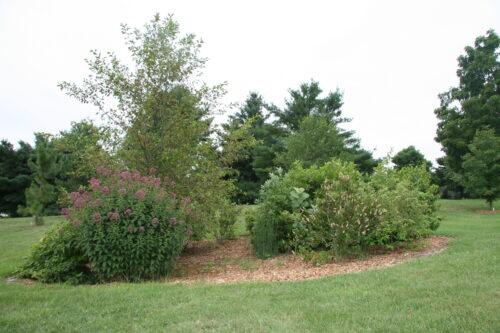 Stormwater runoff is a factor that many cities, towns, and homeowners face. As development increases, so does the presence of impervious or water-resistant surfaces. Trees help to offset this runoff by absorbing, redirecting, and slowing down water in our developed areas.
Stormwater runoff is a factor that many cities, towns, and homeowners face. As development increases, so does the presence of impervious or water-resistant surfaces. Trees help to offset this runoff by absorbing, redirecting, and slowing down water in our developed areas.
Flooding rains can swell waterways to higher than usual levels. Riparian forest buffers are transition areas that protect streams, creeks, or other water bodies from pollutants. Retaining streamside forested buffers and planting riparian forest buffers along waterways in the absence of forested buffers can help protect water resources from pollutants.
How Trees Reduce Stormwater Runoff
Interception
Trunk, leaf, and branch surfaces intercept and absorb water, reducing the amount of water reaching the ground and reducing the volume of peak flows.
Infiltration
Growth of roots and organic decomposition loosens the soil, increasing soil infiltration rate and overall storage capacity.
Transpiration
 Water is drawn up from the soil for the tree to use in photosynthesis. Eventually, the water is released as vapor from the canopy into the atmosphere.
Water is drawn up from the soil for the tree to use in photosynthesis. Eventually, the water is released as vapor from the canopy into the atmosphere.
Phytoremediation
In addition to taking up water, trees also uptake chemicals including fuels, solvents, and metals. Chemicals are either used as nutrients, stored, or transformed into less harmful substances. The more chemicals that are taken up by the tree, the cleaner the soil and better the water quality.
Erosion Control
Tree canopies reduce the velocity and volume of water that falls through the canopy. Slowing the speed at which this water hits the ground, allows time for surfaces to absorb the water, reducing the amount of runoff and erosion of bare soil. Tree roots also grab and hold onto soil particles keeping them in place even during large rain events.
With the proper site design and species selection, trees in urban areas can grow to their full size, live for decades, and provide continuous stormwater management services.
Landowner Actions
There are many actions we can all take around home and on our land, such as building a compost pile, using natural fertilizers and pesticides, building a rain barrel, or planting ground cover in sparsely vegetated areas, to protect water quality.
Learn more about how you can help to manage stormwater runoff and take action to help protect out water resources.
Riparian forest buffers can help protect water resources from pollutants.
Establish rain gardens or other bio-retention features like engineered wetlands and grassy swales to reduce the negative impacts of stormwater runoff from smooth, compact surfaces.
Get guidance about using forest practices such as planting riparian forest buffers to help with stormwater management.
Additional Resources
- Learn more about planting riparian forest buffers.
- Learn more about rain gardens as a stormwater management tool.
- Learn more about stormwater management in urban areas.
| Image | Title | ID | Description | Content Type | View | hf:tax:document-category | hf:tax:Media |
|---|---|---|---|---|---|---|---|
 | Rain Gardens | P00124 | Brochure educates landowners on options available to resolve issues with excess drainage from roofs, gutters, sidewalks, and roads, eliminating soil erosion, improving the quality of water, and how to put nature to work for you. Printed copies available. | Publication | View | urban-and-community-forestry water-quality | publication |
 | Rain Gardens: Technical Guide | P00127 | Technical guide provides detailed instruction for homeowners, teachers, community leaders, gardeners and landscape architects on the planning and development of rain gardens to create a landscape feature that will solve drainage problems, address erosion problems, improve water quality, create wildlife habitat and create a garden focal point. Printed copies available. | Publication | View | urban-and-community-forestry water-quality | publication |
| Stormwater to Street Trees | EPA publication explores engineering urban forests for stormwater management. | Publication | View | urban-and-community-forestry | publication |
Contact Us
Your local DOF forester or forest technician can provide guidance about using forest practices such as planting riparian forest buffers to help with stormwater management. Contact your local DOF forester.
For more information or questions, e-mail us or use our contact form.
